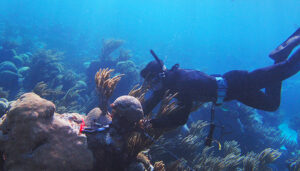Students Fly South for the Winter

This past January a group of 20 students from Colby College spent ten days at BIOS as part of a study abroad program. As part of the fieldwork portion of the course, students used a variety of techniques to make health assessments of Bermuda’s reefs. Duncan Coles, a senior at Colby College majoring in environmental science and biology, took a turn laying a transect tape along the reef floor and collecting photographic images of the area to determine benthic cover, or the types and quantities of various coral and algae species, as well as bottom types such as sand or rock.
As college education becomes as much about experiential learning outside the classroom as it is about lectures, labs, and study halls, many schools have begun to adopt what is known as the “4-1-4” academic calendar. In this system, students have a 4-month semester, then a 1-month “intersession” or “mini session,” followed by another 4-month semester. This offers students a variety of opportunities during this January term, including study abroad programs, internships, undergraduate research, and independent study.
Colby College, a private liberal arts college in Waterville, Maine, is one school operating on the “4-1-4” academic calendar, where their January program (or “Jan Plan”) extends from early January through the first of February. Last month, in collaboration with Bigelow Laboratory for Ocean Sciences in East Boothbay, Maine, a group of Colby students spent ten days at BIOS as part of a “Global Change Impacts on Marginal Marine Ecosystems” study abroad program.
The course, co-taught by Benjamin Neal, assistant professor of environmental studies at Colby College, and Nichole Price, senior research scientist at Bigelow, was attended by 20 Colby students representing four disciplines: geology, chemistry, biology, and environmental science. This is the second time that Price has taught this course at BIOS, which she said she chose as the field location due to its well-equipped teaching labs and access to research boats, as well as its proximity to the East Coast of the U.S. and the welcoming culture of Bermuda.
Prior to arriving at BIOS, the students spent five days at Colby learning the basics of coral reef ecology and practicing in-water skills at the college’s indoor pool. Once in Bermuda, they began their field excursions in more protected, shallow locations, like Whalebone Bay and Fort St. Catherine (both on the eastern end of the island), before transitioning to beach swims from South Shore and, finally, a trip on a BIOS research boat out to North Rock.

The course, which was co-taught by Benjamin Neal, assistant professor at Colby College, and Nichole Price, senior research scientist at Bigelow Laboratory in Maine, was designed to build interest in environmental sciences while also providing students with a foundation in both field and laboratory research techniques.
“The idea of this course is really to give students exposure to a variety of research and analysis techniques,” Price said. “We constructed it to mimic an oceanographic research cruise, so it’s very intensive, and we’ve tried to balance time in the field with laboratory-based projects.” Students were also given time to explore the island, and were tasked with working in groups to give lectures on particular aspects of Bermuda’s history, including topics such as conservation and cultural heritage.
For the fieldwork portion of the course, students formed teams of five and rotated through several roles within the team throughout the trip, Price said this gave them an opportunity to learn “both hard science skills and soft management skills.” Students used a variety of techniques to make health assessments of Bermuda’s reefs, including measuring fish abundance and biomass and taking photographs of benthic communities in standard, rectangular frames called quadrats.
In 2017 Price came to BIOS to install a number of coral settlement tiles around Bermuda’s reefs, as well as thumb-sized CTD sensors that record the seawater’s conductivity (salinity), temperature, and depth. The square, ceramic tiles act as a removable substrate in the reef environment, allowing scientists to monitor which types of coral larvae, and how many, settle and develop, which gives insight into how reefs grow over time.
This year, students retrieved the tiles and examined juvenile corals and other benthic organisms under dissecting microscopes back in BIOS’s teaching labs. Combined with data from the CTDs, they will investigate the relationship between benthic reef ecology and the physical and chemical characteristics of the surrounding ocean.
BIOS marine biologist and ecologist Samantha de Putron also assisted with the course, providing living coral samples, as well as space in her lab for the group to conduct experiments to learn how corals respond to environmental temperature stresses (such as warming seawater associated with global climate change). Students will bring coral samples back to Maine, where they will work at Bigelow to measure coral pigmentation and the relative abundances of zooxanthellae species (symbiotic algae that live within coral tissues).
At the end of the course, students gave a group presentation with their overarching research questions, methods, metrics, and conclusions based on a combination of field and laboratory investigations.
“This course builds student interest and involvement in environmental sciences, particularly marine, and can stimulate student interest in longer programs or internships,” Neal said.
Dominick Leskiw, 19, an environmental studies and English double major at Colby, signed up for the class for an introduction to fieldwork, as his previous science classes were primarily laboratory-based. “It’s so much more fun and meaningful when you are studying something that you care about,” he said, “Being able to share the same experiences with other people is just incredible.”
For Leskiw, this time at BIOS has been especially influential; he said he may switch within his degree program from the environmental policy track to the environmental science track.
